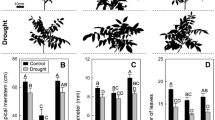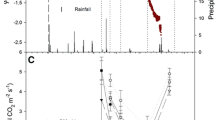Abstract
Reductions in a plant’s ability to transport water, measured as hydraulic conductivity, can impact stomatal conductance and photosynthetic gas exchange. Roots are the plant organs least resistant to cavitation and, due to this, root hydraulic conductivity and vulnerability to cavitation have been proposed as an additional element for seedling quality evaluations. This trait, however, has been poorly characterized for important conifer species preventing the integration of this important physiological trait into criteria for genetic selection and nursery production. In the first part of this study, we modified the original design of the vacuum chamber method allowing for measurements of the whole root system of young conifer seedlings. This method was then compared with standard gravimetric measurements for stems of four tree species and our results confirmed that the vacuum chamber is a reliable technique to measure hydraulic conductance. We were able to perform up to 50 measurements per day of hydraulic conductance of whole root systems using a team of two people, opening the possibility for large scale assessments of root hydraulics, including genetic screening. In the second part of the study, the vacuum chamber method was used to assess the impact of nursery irrigation regime and seedling age on coastal Douglas-fir stem and whole root system hydraulic conductance. When coastal Douglas-fir seedlings grew under limited water availability, roots and stems both experienced a 65% reduction in xylem hydraulic conductance. In contrast to this, Douglas-fir seedling water transport efficiency was reduced more in roots than stems when seedlings were grown under well-watered conditions.







Similar content being viewed by others
References
Alsina MM, Smart DR, Bauerle T, de Herralde F, Biel C, Stockert C, Negron C, Save R (2011) Seasonal changes of whole root system conductance by a drought-tolerant grape root system. J Exp Bot 62:99–109
Anderegg WRL, Venturas MD (2020) Plant hydraulics play a critical role in Earth system fluxes. New Phytol 226:1535–1538
Bogeat-Triboulot MB, Martin R, Chatelet D, Cochard H (2002) Hydraulic conductance of root and shoot measured with the transient and dynamic modes of the high-pressure flowmeter. Ann for Sci 59:389–396
Brodribb TJ, Cochard H, Rodriguez Dominguez C (2019) Measuring the pulse of trees; using the vascular system to predict tree mortality in the twenty-first century. Cons Physiol. https://doi.org/10.1093/conphys/coz046
Brodribb TJ, Holloway-Phillips M, Bramley H (2015) Improving water transport for carbon gain in crops. In: Sadras VO, Calderini DF (eds) Crop physiology applications for genetic improvement and agronomy. Elsevier, London, pp 251–281
de Oliveira PS, Pereira LS, Silva DC, de Souza Junior JO, Laviola BG, Gomes FP (2018) Hydraulic conductivity in stem of young plants of Jatropha curcas L. cultivated under irrigated or water deficit conditions. Ind Crops Prod 116:15–23
Davis SD, Sperry JS, Hacke UG (1999) The relationship between xylem conduit diameter and cavitation caused by freezing. Am J Bot 86:1367–1372
Domec J-C, Warren JM, Meizer FC, Brooks JR, Coulombe R (2004) Native root xylem embolism and stomatal closure in stands of Douglas-fir and ponderosa pine: mitigation by hydraulic redistribution. Oecologia 141:7–16
Domec J-C, Gartner BL (2001) Cavitation and water storage capacity in bole xylem segments of mature and young Douglas-fir trees. Trees 15:204–214
Dumroese RK, Montville ME, Pinto JR (2015) Using container weights to determine irrigation needs: a simple method. Nat Plants J 16:67–71
Eissenstat D, Wells C, Yanai R, Whitbeck J (2000) Building roots in a changing environment: implications for root longevity. New Phytol 147:33–42
Eissenstat DM (1997) Trade-offs in root form and function. In: Jackson LE (ed) Ecology in agriculture. Academic Press, San Diego, pp 173–199
Gonzalez-Benecke CA, Martin TA, Peter GF (2010) Hydraulic architecture and tracheid allometry in mature Pinus palustris and Pinus elliottii trees. Tree Physiol 30:361–375
Gonzalez-Benecke CA, Dinger EJ (2018) Use of water stress integral to evaluate relationships between soil moisture, plant water stress and stand productivity in young Douglas-fir trees. New for 49:775–789
Gonzalez-Benecke CA, Flamenco HN, Wightman MG (2018) Effect of vegetation management and site conditions on volume, biomass and leaf area allometry of four coniferous species in the Pacific Northwest United States. Forests 9:581. https://doi.org/10.3390/f9090581
Gretchen BN, Paterson CA (2005) Water Flow in Roots: structural and regulatory features. In: Michele Holbrook N, Zwieniecki MA (eds) Physiological ecology, vascular transport in plants. Academic Press, San Diego, pp 131–156
Hacke UG, Sperry JS, Ewers BE, Ellsworth DS, Schäfer KVR, Oren R (2000) Influence of soil porosity on water use in Pinus taeda. Oecologia 124:495–505
Harrington JT, Mexal JG, Fisher JT (1994) Volume displacement provides a quick and accurate way to quantify new root production. Tree Planters’ Notes 45:121–124
Johnson DM, Sherrard ME, Domec J-C, Jackson RB (2014) Role of aquaporin activity in regulating deep and shallow root hydraulic conductance during extreme drought. Trees 28:1323–1331
Kavanagh KL, Zaerr JB (1999) Xylem cavitation and loss of hydraulic conductance in western hemlock following planting. Tree Physiol 17:59–63
Kolb KJ, Sperry JS, Lamont BB (1996) A method for measuring xylem hydraulic conductance and embolism in entire root and shoot systems. J Exp Bot 47:1805–1810
Kolb KJ, Sperry JS (1999) Differences in drought adaptation between subspecies of sagebrush (Artemisa tridentata). Ecology 80:2373–2384
Landis TD (1989) Mineral nutrients and fertilization. In: Landis TD, Tinus RW, McDonald SE, Barnett JP (eds), The container tree nursery manual, vol 4. Agriculture Hanbook 674. Washington, DC, USDA, Forest Service, pp 1–67
Melcher PJ, Holbrook NM, Burns MJ, Zwieniecki MA, Cobb AR, Brodribb TJ, Choat B, Sack L (2012) Measurements of stem xylem hydraulic conductivityin the laboratory and field. Methods Ecol Evol 3:685–694
Mencuccini M (2003) The ecological significance of long-distance water transport: short-term regulation, long-term acclimation and the hydraulic costs of stature across plant life forms. Plant Cell Environ 26:163–182
Pinto JR, Marshall JD, Dumroese RK, Davis AS, Cobos DR (2012) Photosynthetic response, carbon isotopic composition, survival, and growth of three stock types under water stress enhanced by vegetative competition. Can J for Res 42:333–344
Pinto JR, Marshall JD, Dumroese RK, Davis AS, Cobos DR (2016) Seedling establishment and physiological responses to temporal and spatial soil moisture changes. New for 47:223–241. https://doi.org/10.1007/s11056-015-9511-7
Pockman WT, Sperry JS (2000) Vulnerability to xylem cavitation and the distribution of Sonoran desert vegetation. Am J Bot 87:1287–1299
Ritchie GA, Shula RG (1984) Seasonal changes of tissue-water relations in shoots and root systems of Douglas-fir seedlings (Pseudotsuga menziesii). For Sci 30:538–548
Robinson DA, Jones SB, Wraith JM, Or D, Friedmanet SP (2003) A review of advances in dielectric and electrical conductivity measurement in soils using time domain reflectometry. Vadose Zone J 2:444–475
Sloan JL, Burney OT, Pinto JR (2020) Drought-conditioning of quaking aspen (Populus tremuloides Michx.) seedlings during nursery production modifies seedling anatomy and physiology. Front Plant Sci 11:557894. https://doi.org/10.3389/fpls.2020.557894
Sperry JS, Donnelly JR, Tyree MT (1988) A method for measuring hydraulic conductivity and embolism in xylem. Plant Cell Environ 11:35–40
Sperry JS, Ikeda T (1997) Xylem cavitation in roots and stems of Douglas-fir and white fir. Tree Physiol 17:275–280
Sperry JS, Alder FR, Campbell GS, Comstock JP (1998) Limitation of plant water use by rhizosphere and xylem conductance: results from a model. Plant Cell Environ 21:347–359
Sperry JS, Hacke UG, Oren R, Comstock JP (2002a) Water deficits and hydraulic limits to leaf water supply. Plant Cell Environ 25:251–263
Sperry JS, Stiller V, Hacke UG (2002b) Soil water uptake and water transport through root systems. In: Waisel Y, Eshel A, Kafkafi U (eds) Plant roots: the hidden half, 3rd edn. Marcel Dekker, New York, pp 663–681
Timmis R (1980) Stress resistance and quality criteria for tree seedlings: analysis, measurement and use. N Z J for Sci 10:21–53
Torres-Ruiz JM, Sperry JS, Fernandez JE (2012) Improving xylem hydraulic conductivity measurements by correcting the error caused by passive water uptake. Physiol Plant 146:129–135
Tsuda M, Tyree MT (1997) Whole-plant hydraulic resistance and vulnerability segmentation in Acer saccharinum. Tree Physiol 17:351–357
Tsuda M, Tyree MT (2000) Plant hydraulic conductance measured by high pressure flow meter in crop plants. J Exp Bot 51:823–828
Tyree MT (1998) Hydraulic properties of roots. Hydraulic properties of roots. In: de Kroon H, Visser EJW (eds) Root Ecology. Ecological studies (analysis and synthesis). Springer, Berlin, pp 125–150
Tyree MT (2003) Hydraulic limits on tree performance: transpiration, carbon gain and growth of trees. Trees 17:95–100
Tyree MT, Sinclair B, Liu P, Granier A (1993) Whole shoot hydraulic resistance in Quercus species measured with a new high-pressure flow meter. Ann Sci for 50:417–423
Tyree MT, Patiño S, Bennink J, Alexander J (1995) Dynamic measurements of root hydraulic conductance using a high-pressure flowmeter in the laboratory and field. J Exp Bot 46:83–94
Tyree MT, Velez V, Dalling JW (1998) Growth dynamics of root and shoot hydraulic conductance in seedlings of five neotropical tree species: scaling to show possible adaptation to differing light regimes. Oecologia 114:293–298
Venturas MD, Sperry JS, Love DM, Frehner EH, Allred MG, Wang Y, Anderegg WRL (2018) A stomatal control model based on optimization of carbon gain versus hydraulic risk predicts aspen sapling responses to drought. New Phytol 220:836–850
Venturas MD, Pratt RB, Jacobsen AL, Castro V, Fickle JC, Hacke UG (2019) Direct comparison of four methods to construct xylem vulnerability curves: differences among techniques are linked to vessel network characteristics. Plant Cell Environ 42:2422–2436
Wang Y, Sperry JS, Anderegg WRL, Venturas MD, Trugman AT (2020) A theoretical and empirical assessment of stomatal optimization modeling. New Phytol 227:311–325
Acknowledgements
The authors gratefully acknowledge the support provided by the Vegetation Management Research Cooperative at Oregon State University. The authors also acknowledge Ms. Emily Dinsbury, Mr. Claudio Guevara and Mr. Noah Lindquist for helping with seedling measurements, and Dr. Sara Lipow, Dr. Andrew Nelson, Mr. Bill Marshall, Mr. Bryan Nelson and Mr. Fred Pfund for sharing seedlings, and Mr. Cristobal Gonzalez for providing insights and edits on the manuscript.
Author information
Authors and Affiliations
Corresponding author
Ethics declarations
Conflict of interest
The authors declare that they have no conflict of interest.
Additional information
Publisher's Note
Springer Nature remains neutral with regard to jurisdictional claims in published maps and institutional affiliations.
Rights and permissions
Springer Nature or its licensor (e.g. a society or other partner) holds exclusive rights to this article under a publishing agreement with the author(s) or other rightsholder(s); author self-archiving of the accepted manuscript version of this article is solely governed by the terms of such publishing agreement and applicable law.
About this article
Cite this article
Gonzalez-Benecke, C.A., Alzugaray-Oswald, P.J. & Wightman, M.G. Determining the effect of age and drought stress on the hydraulic conductance and vulnerability to cavitation of Douglas-fir seedling root systems using the vacuum method. New Forests 53, 1003–1020 (2022). https://doi.org/10.1007/s11056-022-09945-7
Received:
Accepted:
Published:
Issue Date:
DOI: https://doi.org/10.1007/s11056-022-09945-7




